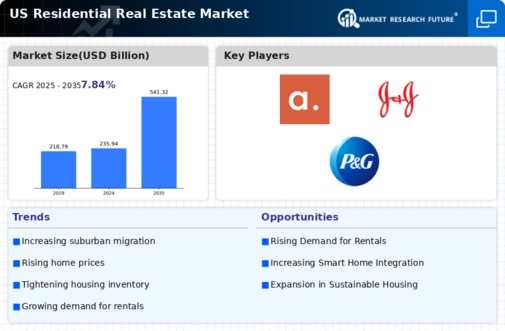The residential real estate market in the US is currently characterized by a dynamic competitive landscape, driven by technological advancements, shifting consumer preferences, and evolving economic conditions. Key players such as Zillow Group (US), Redfin Corporation (US), and Keller Williams Realty (US) are at the forefront of this transformation. Zillow Group (US) has strategically positioned itself as a leader in digital real estate services, focusing on enhancing user experience through innovative technology and data analytics. Redfin Corporation (US), on the other hand, emphasizes a tech-driven approach to real estate transactions, leveraging its proprietary platform to streamline processes and reduce costs. Keller Williams Realty (US) continues to expand its footprint through a robust franchise model, prioritizing agent training and support to foster a strong community of real estate professionals. Collectively, these strategies contribute to a competitive environment that is increasingly reliant on technology and customer-centric solutions.
In terms of business tactics, companies are increasingly localizing their operations to better serve regional markets, optimizing their supply chains to enhance efficiency. The competitive structure of the market appears moderately fragmented, with numerous players vying for market share. However, the influence of major companies like Zillow Group (US) and Redfin Corporation (US) is substantial, as they set benchmarks for innovation and service delivery that smaller firms often strive to emulate.
In November 2025, Zillow Group (US) announced a partnership with a leading AI firm to enhance its property valuation algorithms. This strategic move is likely to bolster Zillow's competitive edge by providing more accurate and timely property assessments, thereby improving user trust and engagement. Such advancements in technology are crucial in a market where consumers increasingly demand transparency and efficiency in real estate transactions.
In October 2025, Redfin Corporation (US) launched a new feature that allows users to conduct virtual home tours using augmented reality. This initiative not only caters to the growing demand for digital solutions but also positions Redfin as a pioneer in integrating cutting-edge technology into the home-buying process. The ability to offer immersive experiences could significantly enhance customer satisfaction and drive sales, particularly among tech-savvy buyers.
In September 2025, Keller Williams Realty (US) expanded its training programs to include modules on digital marketing and social media strategies. This initiative reflects a broader trend within the industry, where real estate professionals are increasingly required to adapt to digital platforms to reach potential clients effectively. By investing in agent education, Keller Williams is likely to strengthen its market position and foster loyalty among its agents, which could translate into higher sales volumes.
As of December 2025, the competitive trends in the residential real estate market are heavily influenced by digitalization, sustainability, and the integration of AI technologies. Strategic alliances among key players are shaping the landscape, as companies seek to leverage each other's strengths to enhance service offerings. Looking ahead, it appears that competitive differentiation will increasingly hinge on innovation and technology rather than traditional price-based competition. The emphasis on supply chain reliability and customer experience is likely to define the future trajectory of the market, as firms strive to meet the evolving expectations of consumers.














Leave a Comment